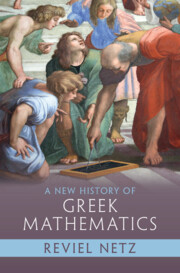Book contents
- A New History of Greek Mathematics
- A New History of Greek Mathematics
- Copyright page
- Dedication
- Contents
- Plates
- Preface
- Acknowledgments
- Chapter 1 To the Threshold of Greek Mathematics
- Chapter 2 The Generation of Archytas
- Chapter 3 The Generation of Archimedes
- Chapter 4 Mathematics in the World
- Chapter 5 Mathematics of the Stars
- Chapter 6 The Canonization of Greek Mathematics
- Chapter 7 Into Modern Science: The Legacy of Greek Mathematics
- Epilogue: Bringing to the Boil
- Index
Epilogue: Bringing to the Boil
Published online by Cambridge University Press: 01 September 2022
- A New History of Greek Mathematics
- A New History of Greek Mathematics
- Copyright page
- Dedication
- Contents
- Plates
- Preface
- Acknowledgments
- Chapter 1 To the Threshold of Greek Mathematics
- Chapter 2 The Generation of Archytas
- Chapter 3 The Generation of Archimedes
- Chapter 4 Mathematics in the World
- Chapter 5 Mathematics of the Stars
- Chapter 6 The Canonization of Greek Mathematics
- Chapter 7 Into Modern Science: The Legacy of Greek Mathematics
- Epilogue: Bringing to the Boil
- Index
Summary
In a world of ambitious mathematicians, each vying to become the new Archimedes, Evangelista Torricelli, born in Faenza, Italy, in 1608, was determined to out-Archimedes them all. The one book he published in his short life (he died at age thirty-nine) is the Geometrical Works, a series of mathematical marvels, some reproducing results from Archimedes, some extending the spirit of Archimedes by measuring new curved figures. Torricelli may have been the first to measure the area of the cycloid, a figure originally proposed by Galileo. (The seventeenth century was full of Archimedes-like challenges; unlike in the third century bce, such challenges tended to generate many responses, with many ensuing fights over priority.) He invented and measured his own—paradoxical—figure. Consider a hyperbola, one of its asymptotes, and some perpendicular to that asymptote cutting the hyperbola. The three taken together define an infinitely long figure that is widest at its base (the perpendicular) and keeps narrowing—without ever reaching the zero width of a point—as it moves away from that base. Rotate this figure around the asymptote, and you get an infinitely long solid, shaped rather like an infinitely long, curved funnel. Torricelli measured the volume of this infinite solid—which turned out to be, incredibly, finite. Infinite surface, finite volume! A new Archimedes, right there!
- Type
- Chapter
- Information
- A New History of Greek Mathematics , pp. 502 - 511Publisher: Cambridge University PressPrint publication year: 2022

